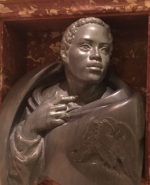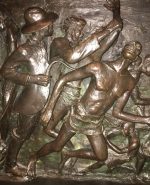- Our Lady of Africa
- Slave master
Location: The Basilica of the National Shrine of the Immaculate Conception, 400 Michigan Ave NE, Washington, DC 20017
“A gift to the National Shrine from African-American Catholics under the leadership of the Black Bishops of the United States and the National Black Catholic Congress, the chapel “is an enduring testimony to the abiding faith of the African American peoples and their unwavering devotion to the Blessed Virgin Mary,” said Msgr. Walter Rossi, rector of the National Shrine.
The chapel features a statue of Our Mother of Africa holding the Christ Child. The larger than life rendering faces a bas relief that illustrates the experiences of African Americans from the time of slavery until the civil rights movement.
The bas relief – which is read from right to left – begins with slave traders kidnapping residents of an African village. It depicts the struggles of slaves and the hardships they endured. There are images of the fight for freedom and the Civil Rights movement. The image concludes with a modern day family stepping out of the image and leading towards Christ. Over all of this history hovers a dove, symbolizing the Holy Spirit and His loving care for His suffering children.
The statue of Mary is depicted walking toward the bas relief and the Christ Child points to it – a symbol of Jesus’ and Mary’s attentiveness to the plight of African Americans and a call for all to look and learn the history of African Americans.
The family stepping out of the bas relief reaches for the hand of Jesus on the nearby crucifix. The crucifix, which hangs over a marble altar, is completed in the tradition of the Entebene … of Tanzania. The body of Christ is completed in ebony hardwood and the cross is of cherry wood.
The chapel is supported by seven pillars that represent the seven principals of African American society: Umoja (unity); Kujichagulia (self-determination); Ujima (collective work and responsibility); Ujamaa (family); Nia (prupose); Kuumba (creativity); and Imani (faith).
The ceiling of the chapel is constructed of wood to recall the colonial homes in which the slaves were kept and to recall the hulls of the ships which brought the slaves to America.
Carved in marble in Ge’ez, the ancient Ethiopian liturgical language, are two passages from Isaiah (49:15 and 9:1, 3, 5). One evokes Mary’s tenderness for her children, the other is a promise that a redeemer will be born upon whose shoulder dominion rests and who will smash the rod of the taskmaster.
At the entrance to the chapel on the is a stylized depiction of a 17th-century slave ship. Throughout the chapel are etchings of fish and water – symbols of Christ and reminders of the slaves’ crossing the ocean from Africa to America.
There are also sculptural busts of the four evangelists, and iron gates depicting the Acacia Tree. The tree, a species native to Africa, has deep roots and can survive through drought and famine. It is a metaphor for Black Catholics whose faith survived during years of enslavement and hardship… Catholic Standard
Photo credits: Africa Access
Date added : 8/13/18



